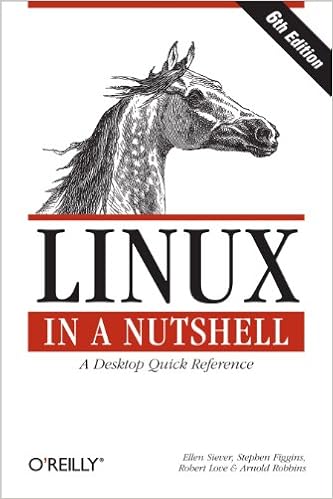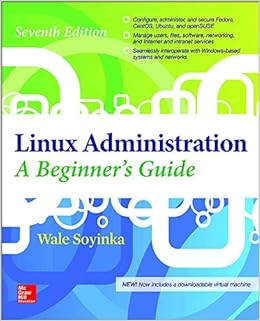15 BEST Linux Books (2025 Update)
We are reader supported and may earn a commission when you buy through links on our site
Linux is an operating system based on UNIX and was first introduced by Linus Torvalds. It is based on the Linux Kernel and can run on different hardware platforms manufactured by Intel, MIPS, HP, IBM, SPARC, and Motorola.
Are you interested in learning the Linux language/skills and looking for some excellent book that will help you skyrocket your Linux expertise? Then you have come to the right place.
Here is a curated list of the best books to learn Linux for beginners. These books are highly recommended by Linux experts and are helpful for students to grasp the programming fundamentals. These resources will guide you to build your career in this promising field and make you a better Linux developer. Read more…
Best Linux Books
| Book Title | Author Name | Latest Edition | Publisher | Ratings | Link |
|---|---|---|---|---|---|
| The Linux Command Line | William Shotts | 2nd edition | No Starch Press |  |
Learn More |
| Linux for Beginners | Jason Cannon | 1st edition | Independently Published |  |
Learn More |
| Linux Command Line and Shell Scripting Bible | Richard Blum | 3rd edition | Wiley |  |
Learn More |
| Command Line Kung Fu | Jason Cannon | 1st edition | Independently Published |  |
Learn More |
| Linux Administration | Jason Cannon | 3rd edition | Independently Published |  |
Learn More |
1) The Linux Command Line
Author Name: William Shotts
Publisher: No Starch Press
Latest Edition: 2nd edition
No of Pages: 504 pages
The Linux Command Line is a book written by William Shotts. The author takes you from your very first terminal keystrokes to writing full programs using a Linux shell or command line.
In this book, you will also learn file navigation, environment configuration, pattern matching with regular expressions, etc. Apart from practical knowledge, the book also reveals the basic concept of every topic.
2) Linux for Beginners: An Introduction to the Linux Operating System and Command Line
Author Name: Jason Cannon
Publisher: Independently Published
Latest Edition: 1st edition
No of Pages: 204 pages
Linux for Beginners is a book written by Jason Cannon. The best part of this book is that you don’t need any prior knowledge of Linux OS. You will be guided using step by step logical and systematic approach.
This learning material also covers new concepts or jargon are encountered. The best thing about this tutorial book is that every detail are covered in this book in an easy to understand language and its basic concepts.
3) Linux Command Line and Shell Scripting Bible, 3rd Edition
Author Name: Richard Blum
Publisher: Wiley
Latest Edition: 3rd edition
No of Pages: 816 pages
Linux Command Line and Shell Scripting Bible is a reference book written by Richard Blum. The book includes detailed instructions and abundant examples.
To use this book, you will learn how to bypass the graphical interface and communicate with your computer. This Linux book thirty pages of new functional examples that are fully updated to align with the latest Linux features.
It starts with command line fundamentals. The book gives information about shell scripting and shows you the practical application of commands for automatic, frequently performed functions.
4) Command Line Kung Fu
Author Name: Jason Cannon
Publisher: Independently Published
Latest Edition: 1st edition
No of Pages: 126 pages
Command Line Kung Fu is a book written by Jason Cannon. The book also includes packed with dozens of tips and over 100 practical, real-world examples. The examples given in this book help you to solve actual problems and accomplish worthwhile goals.
The book has a comprehensive index is included. So even if you want to find every example where a given command is used -even if it is not the main subject.
5) Linux Administration
Author Name: Jason Cannon
Publisher: Independently Published
No of Pages: 204 pages
Linux Administration is a book written by Jason Cannon. This Linux learning material includes topics like Ubuntu Linux, Debian, Linux Mint, RedHat Linux, Fedora, SUSE Linux, Kali Linux, and more.
By the end of this Linux book, you will fully understand the most important and fundamental concepts of Linux server administration. Moreover, you will be able to put those concepts to use in various real-world situations.
6) Linux: The Complete Reference
Author Name: Richard Petersen
Publisher: Independently Published
Latest Edition: 6th edition
No of Pages: 830 pages
The Complete Reference is a book written by Richard Petersen. The book includes various Linux features, tools, and utilities from this thoroughly updated and comprehensive resource.
This Linux book also covers use the desktops and shells, manage applications, deploy servers, and handle system and network admin tasks.
The book includes various details on the very different and popular Ubuntu and Red Hat/Fedora software installation. The book also teaches you tools used by different distributions.
7) How Linux Works
Author Name: Brian Ward
Publisher: No Starch Press
Latest Edition: 3rd edition
No of Pages: 464 pages
How Linux Works, is a book written by Brian Ward. The book teaches you the concepts behind Linux internals. It is ideal reference material for anyone curious to know about the operating system’s inner workings.
You will also learn how development tools work and how to write effective shell scripts. In this book, you will also explore the kernel and examine key system tasks like system calls, input and output, and file systems.
8) Advanced Programming in the UNIX Environment, 3rd Edition
Author Name: W. Stevens
Publisher: Addison-Wesley
Latest Edition: 3rd edition
No of Pages: 1032 pages
Advanced Programming in the UNIX Environment, written by Stephen A. Rago. This Linux book begins with files, directories, and processes, and then takes you to more advanced Linux techniques. The writer also covers threads and multithreaded programming, and socket-based IPC.
This book covers more than seventy new interfaces, including POSIX asynchronous I/O, spin locks, barriers, and POSIX semaphores, etc. The book offers several chapter-length case studies, each reflecting contemporary environments.
9) Linux Kernel Development: Linux Kernel Development
Author Name: Love Robert
Publisher: Addison-Wesley Professional
Latest Edition: 3rd edition
No of Pages: 470 pages
Linux Kernel Development is a book written by Robert Love. The book gives details about the design and implementation of the Linux kernel. The writer is presenting the content in a manner that is beneficial to those writing and developing kernel code.
It is also an ideal book for programmers seeking to understand the Linux OS better. The book offers features of the Linux kernel, which includes its design, implementation, and interfaces.
10) The Art of UNIX Programming (The Addison-Wesley Professional Computing Series)
Author Name: Eric Raymond
Publisher: Addison-Wesley
Latest Edition: 1st edition
No of Pages: 560 pages
The Art of Unix Programming is a book written by Eric S. Raymond.
This Linux book reveals the software design secrets of the original Unix designers. It also shows how they produce software that is fast, portable, reusable, modular, and long-lived.
The book covers topics like Basic of Unix Philosophy, Unix history, OS comparisons, Best practices, Finding notation that sings, etc. The book also includes 12 case studies to know the use of Linux in real-life applications.
11) Linux in a Nutshell: A Desktop Quick Reference
Author Name: Ellen Siever
Publisher: O′Reilly
Latest Edition: 6th edition
No of Pages: 942 pages
Linux, in a Nutshell, is a book written by Stephen Figgins. The book includes programming tools, system and network administration tools, the shell, editors, etc.
This book focuses on Linux system essentials, as well as more coverage of new capabilities such as virtualization, revision control with git. It also includes an option for using the vast number of Linux commands.
12) The Linux Programming Interface
Author Name: Michael Kerrisk
Publisher: No Starch Press
Latest Edition: 1st edition
No of Pages: 1552 pages
The Linux Programming Interface is a book written by Michael Kerrisk. In this book, the author provides detailed descriptions of the system calls and library functions that you need to learn Linux programming, etc.
This book covers the wealth of Linux-specific features, including epoll, notify, and the /proc file system. The book emphasis on UNIX standards (POSIX.1-2001/SUSv3 and POSIX.1-2008/SUSv4). At the same time, this Linux book is also equally valuable to programmers working on other UNIX platforms.
13) Linux System Programming: Talking Directly to The Kernel And C Library
Author Name: Robert Love
Publisher: O′Reilly
Latest Edition: 2nd edition
No of Pages: 456 pages
Linux System programming is a book written by Robert Love. The book provides learning material on Linux system programming, a reference manual on Linux system calls. The book is an ideal guide to learn about writing smarter, faster code.
The book helps you to distinguish between POSIX standard functions and special services offered only by Linux. The book also includes a chapter on multithreading. This best linux books for beginners provides an in-depth look at Linux from both a theoretical and applied perspective.
14) Linux Administration: A Beginner’s Guide, Seventh Edition
Author Name: Wale Soyinka
Publisher: McGraw-Hill Education
Latest Edition: 7th edition
No of Pages: 848 pages
Linux Administration is a book written by Wale Soyinka. The book teaches you how you can effectively set up and manage any version of Linux on individual servers or using this practical resource.
It is one of the best Linux books that offers clear explanations, step-by-step instructions, and real-world examples.
You will also learn how to configure hardware and software, work from the GUI or command line, maintain Internet and network services. This book included Software management and backup solutions.
FAQ:
🏅 What is Linux?
LINUX is an operating system or a kernel distributed under an open-source license. Its functionality list is quite like UNIX. The kernel is a program at the heart of the Linux operating system that takes care of fundamental stuff, like letting hardware communicate with software.
📚 Which are the Best Linux Books?
Following are some of the Best Linux Books for Beginners & Advanced Programmers:
- The Linux Command Line
- Linux for Beginners: An Introduction to the Linux Operating System and Command Line
- Linux Command Line and Shell Scripting Bible, 3rd Edition
- Command Line Kung Fu
🚀 What are the basic requirements to learn Linux?
Nothing! This book list is designed for beginners to expert-level linux professionals.














